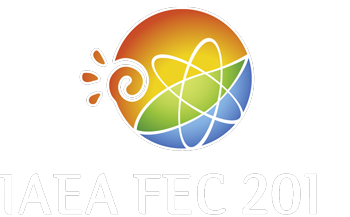Speaker
Dr
Kristel Crombe
(Ghent University, Belgium)
Description
IShTAR (Ion Sheath Test ARrangement) is dedicated to the investigation of the interactions between
an ICRF antenna and a plasma in the conditions (plasma temperature and density, magnetic
configuration) representative of the plasma edge of a magnetic confinement fusion machine. The
test bed is composed of a helicon plasma source and a main vessel, in which a dedicated single strap
ICRF antenna is installed.
Firstly, the optimization of the plasma source in order to get the highest density and most radially
uniform plasma is presented (by changing of the position of the source and by scanning the
operational parameters). In addition, the efficiency of the installed diagnostics (compensated/noncompensated
Langmuir probes, B-dot probes, wideband spectrometer) is discussed.
The second part addresses the effect of the ICRF operation on the generated plasma; the wave
profiles in vacuum and plasma are recorded. The impact of the eigenmodes due to the small size of
the vessel on the wave field at the interface antenna/plasma is evaluated. The effect of the
additional ionization on the density profile is also measured with the spatial variation of the plasma
potential near and inside the RF sheath in front of the antenna strap.
Finaly, the feasibility of a diagnostic to directly measure the electrical field in the sheath by using the
change in emission from energy levels modified by Stark effect and mixing is discussed.
| Country or International Organization | Belgium |
|---|---|
| Paper Number | EX/P6-48 |
Author
Dr
Kristel Crombe
(Ghent University, Belgium)
Co-authors
Ms
Ana Kostic
(Department of Applied Physics, Ghent University, Belgium)
Dr
Anton Nikiforov
(Department of Applied Physics, Ghent University, Belgium)
Dr
Dirk Van Eester
(LPP-ERM/KMS)
Dr
Eric Faudot
(Institut Jean Lamour UMR 7198 CNRS-Université de Lorraine, Nancy, France)
Dr
Fabrice Louche
(LPP-ERM-KMS, TEC partner, Brussels, Belgium)
Dr
Helmut Faugel
(Max-Planck-Institut für Plasmaphysik, Garching, Germany)
Dr
Helmut Fuenfgelder
(Max-Planck-Institut für Plasmaphysik, Garching, Germany)
Prof.
Jean-Marie Noterdaeme
(Max Planck Institute for Plasma Physics)
Dr
Jerome Moritz
(Institut Jean Lamour UMR 7198 CNRS-Université de Lorraine, Nancy, France)
Mr
Joel Moreno
(Department of Applied Physics, Ghent University, Belgium)
Dr
Jonathan Jacquot
(Max-Planck-Institut für Plasmaphysik, Garching, Germany)
Ms
Mariia Usoltseva
(Department of Applied Physics, Ghent University, Belgium)
Dr
Rodolphe D'Inca
(Max-Planck-Institut für Plasmaphysik, Garching, Germany)
Dr
Roman Ochoukov
(Max-Planck-Institut für Plasmaphysik, Garching, Germany)
Dr
Stephane Devaux
(Institut Jean Lamour UMR 7198 CNRS-Université de Lorraine, Nancy, France)
Prof.
Stephane Heuraux
(Institut Jean Lamour UMR 7198 CNRS-Université de Lorraine, Nancy, France)

